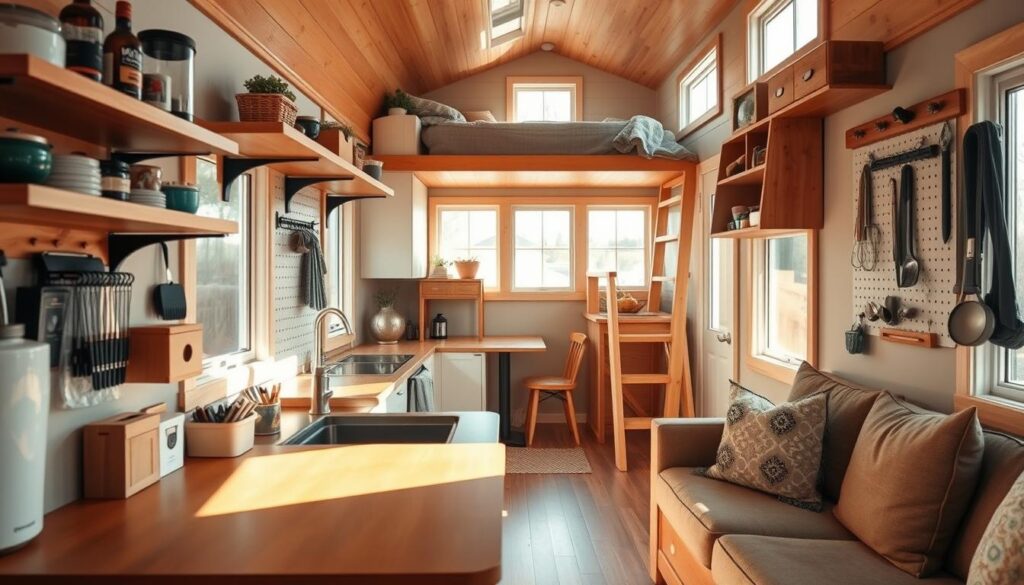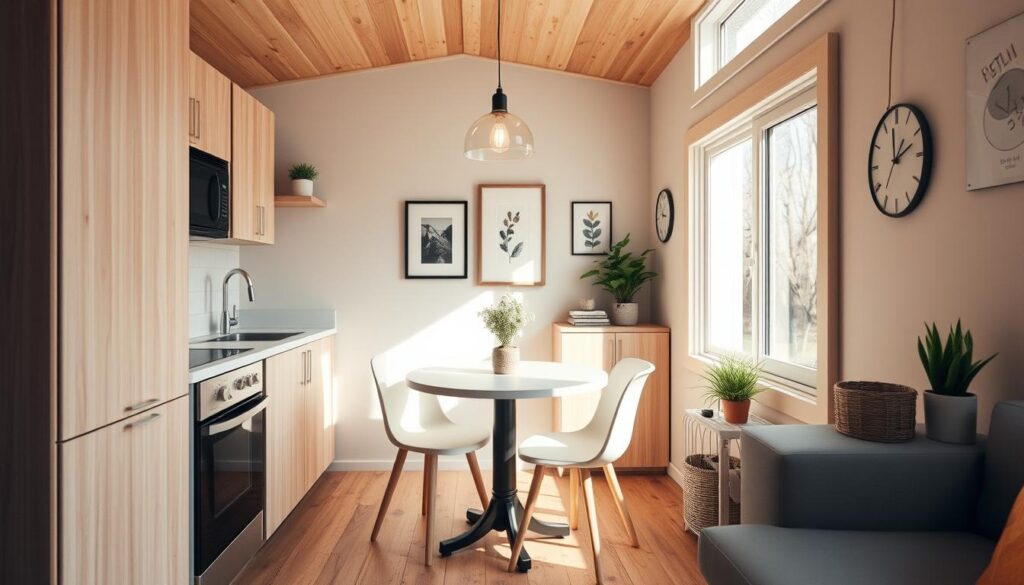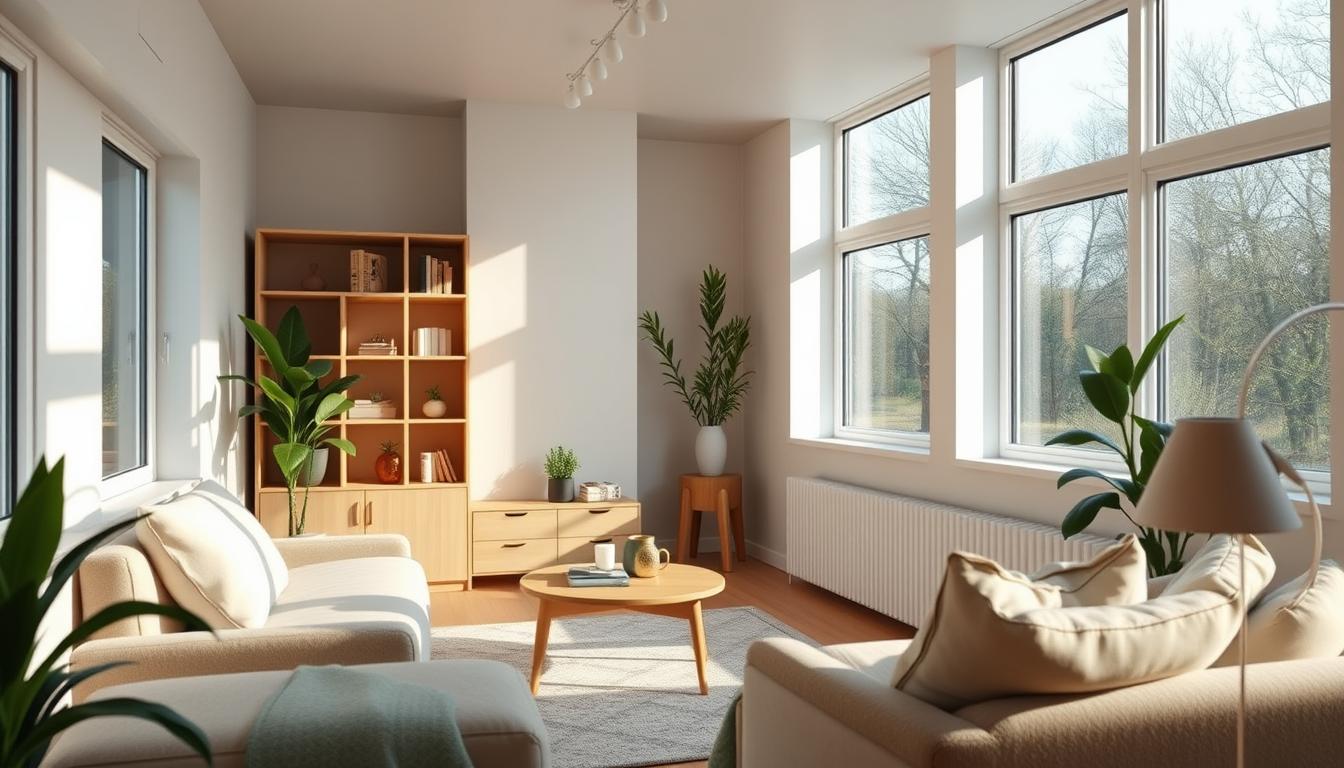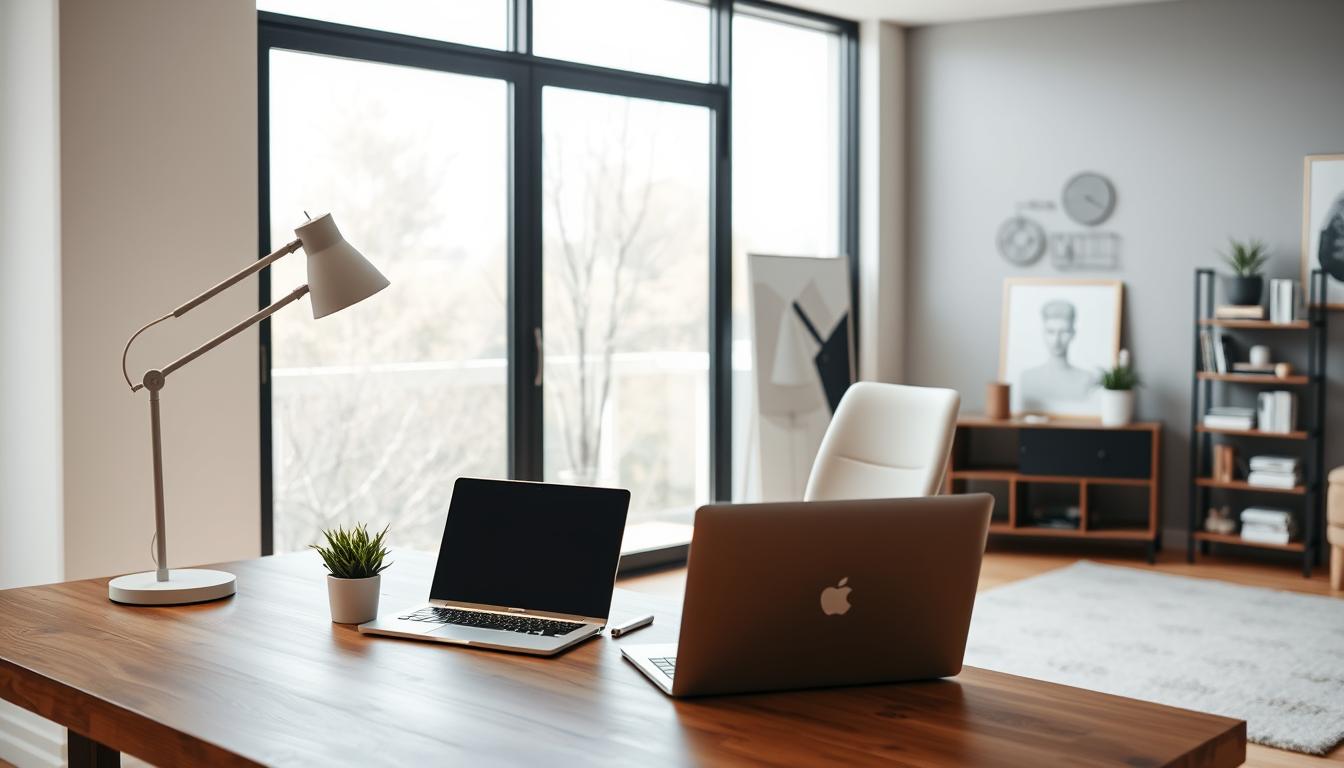Did you know the average American home is over 1,000 square feet per person? Tiny homes, on the other hand, are under 500 square feet. This shows the innovative design challenges and chances in small space living.
Designing a tiny house is a rewarding challenge. It encourages multifunctional layouts and smart storage. All while supporting sustainable living practices. We’ll show how to use limited space well, focusing on tiny home interior design that’s both useful and beautiful.
By choosing sustainable living and smart design, tiny home dwellers can live an eco-friendly and cozy life. We’ll share tips on making the most of every square foot in tiny homes.
Key Takeaways
- Efficient storage is crucial in small space design.
- Multifunctional furniture enhances the livability of tiny homes.
- Sustainable living practices are integral to tiny home living.
- Innovative design can make tiny homes feel spacious.
- Maximizing vertical space is key to a comfortable tiny home interior.
Understanding the Tiny Home Concept
Tiny homes are more than a trend. They show a move towards living in a more sustainable and efficient way. This lifestyle focuses on simplicity and cuts down on environmental harm.
Definition of Tiny Homes
Tiny homes are smaller than 400 square feet. They are built to be very efficient. They use tiny house furniture that does more than one thing.
This style of living leads to minimalist decor. It looks good and works well.
These homes also have eco-friendly interior features. Think reclaimed wood, low-VOC paints, and energy-saving appliances. These features help the environment and make homes healthier.
Benefits of Tiny Living
Living in a tiny home has many perks. One big plus is saving money. With less space, you need less expensive furniture and decor. Plus, your utility bills drop.
Another benefit is living more sustainably. Tiny homes use fewer resources and make less waste. This lifestyle makes you think more about what you use, leading to a greener way of living.
| Benefits | Description |
|---|---|
| Financial Savings | Reduced expenses on utilities, furniture, and maintenance. |
| Environmental Impact | Lower consumption of resources and reduced waste production. |
| Simplified Living | Less clutter and a more organized living space. |
Importance of Interior Design in Tiny Homes
Effective interior design is key to making tiny homes cozy and comfortable. It turns small spaces into welcoming homes. Interior design is vital in tiny homes to make the most of space and create a cozy feel.
When designing a tiny home, focus on functionality over aesthetics. This doesn’t mean the space has to look plain. It means choosing designs that are useful and serve more than one purpose.
Functionality Over Aesthetics
To achieve functionality, consider these space-saving solutions:
- Multi-functional furniture that serves more than one purpose.
- Compact appliances that fit snugly into the available space.
- Storage solutions that utilize vertical space effectively.
By focusing on functionality, we can make a tiny home that looks great and is easy to live in.
Creating a Cozy Atmosphere
Creating a cozy atmosphere in a tiny home is more than just picking furniture. It’s about making a space that feels warm and welcoming.
Some ways to create a cozy atmosphere include:
- Using warm lighting to create a sense of comfort.
- Incorporating textiles such as throw blankets and rugs to add warmth.
- Selecting a color palette that promotes relaxation and calmness.
By balancing functionality with coziness, we can make a tiny home that’s both efficient and enjoyable.
Smart Layout Strategies
Effective tiny home design relies on smart layout planning. We must tackle the unique challenges and opportunities of tiny home interiors. This way, we can make a living space that is both functional and comfortable.
Open Floor Plans
One top space-saving solution for tiny homes is open floor plans. By removing walls and partitions, we make the space feel bigger. This improves the flow between different areas of the home.
Open floor plans also let us arrange furniture in many ways. This makes the space feel more minimalist and less cluttered. It encourages a more streamlined and efficient use of space.
Multi-Functional Rooms
Another key strategy in tiny home design is multi-functional rooms. By designing rooms that serve more than one purpose, we make the most of the space. This doesn’t mean we have to give up comfort or functionality.
For instance, a living room can also be a guest bedroom with a murphy bed or sofa bed. A kitchen can also include a dining area, cutting down on the need for a separate dining room.
Multi-functional rooms save space and help achieve a more minimalist decor. They reduce the number of rooms and the furniture and decor needed.
By using smart layout strategies like open floor plans and multi-functional rooms, we can design tiny home interiors that are both functional and beautiful.
Choosing the Right Color Palette
In tiny homes, the color palette is key to making the space feel bigger. The right colors can make a tiny home feel spacious and inviting.
Light Colors for Space Illusion
Light colors on walls, ceilings, and floors can make a space look bigger. Light colors reflect light, making the area feel brighter and more open. This trick works well in small space design, where every detail matters.
Popular light colors include soft whites, creamy beiges, and pale grays. These colors not only make spaces look larger but also add a clean, minimalist look. This is typical of eco-friendly interiors.
| Color | Effect on Space | Ideal for |
|---|---|---|
| Soft White | Makes space feel larger and brighter | Ceilings and walls |
| Creme Beige | Adds warmth without making space feel smaller | Walls and furniture |
| Pale Gray | Creates a calm and serene atmosphere | Accent walls and decor |
Accent Colors to Enhance Design
While light colors are crucial for space illusion, accent colors add personality. Accent colors can be used in furniture, decor, or a single accent wall. Choose colors that match the overall palette and highlight sustainable living in your home.
For example, a bold color like teal or coral can add vibrancy. But, it’s important to balance these colors with the main palette to avoid overwhelming the space.
By picking a color palette with light colors for space illusion and accent colors for personality, you can make a tiny home feel spacious, welcoming, and eco-friendly.
Furniture Selection for Tiny Spaces
Choosing furniture for tiny homes is very important. It’s all about using space wisely. Every piece of furniture must be useful and stylish.
Space-Saving Furniture Options
One smart way to furnish a tiny home is to pick furniture that saves space. This includes:
- Multi-functional pieces, like a sofa bed or a coffee table with storage, which can serve more than one purpose.
- Wall-mounted furniture, like foldable tables and shelves, that can be tucked away when not in use.
- Nesting furniture, which can be stacked or nested together to save space.
Using these space-saving options, tiny home dwellers can enjoy a roomier and cleaner living area.
The Role of Built-In Furniture
Built-in furniture is also great for tiny homes. It’s made to fit perfectly, making the most of every corner.
Some benefits of built-in furniture include:
- Optimized storage: Built-in furniture can provide lots of storage, keeping things tidy.
- Streamlined appearance: Built-in pieces can make the space look sleek and cohesive, improving the tiny home’s look.
- Increased functionality: By adding functional elements, like built-in desks or shelves, built-in furniture can make the space more useful.
In short, picking the right furniture is key in tiny homes. By choosing furniture that saves space and adding built-in pieces, residents can create a cozy, stylish, and practical living area.
Creative Storage Solutions
In tiny homes, every inch matters. Creative storage solutions are essential. We must find ways to keep things organized without losing style or comfort. Good storage keeps our homes tidy and livable.

Utilizing Vertical Space
Using vertical space is a smart way to add storage. Shelves, hooks, and units that reach the ceiling boost storage. This approach keeps things neat and makes the space seem bigger.
- Use wall-mounted shelves for books, decorative items, and kitchenware.
- Install hooks for hanging items like bikes, pots, and pans.
- Opt for tall, narrow storage units that fit into tight spaces.
Hidden Storage Ideas
Hidden storage is key in tiny homes. Hidden storage ideas help keep clutter away. Look for furniture with built-in storage, like ottomans or beds with drawers.
- Choose multi-functional furniture pieces that serve more than one purpose.
- Utilize the space under beds and sofas with storage bins or drawers.
- Invest in furniture with secret compartments or hidden storage.
By using these space-saving solutions and minimalist decor, we can make our tiny homes feel spacious and organized. They become truly our own.
Lighting Techniques to Brighten Up
Proper lighting can change a tiny home’s feel, making it seem bigger and more inviting. In the world of sustainable living, good lighting is key to making tiny homes eco-friendly.
Lighting in tiny homes greatly impacts the space’s feel. Let’s look at some effective ways to light up your home.
Natural Light Maximization
Getting more natural light is a top way to brighten a tiny home. You can do this by:
- Installing bigger windows or skylights for more light.
- Using sheer curtains or blinds to control light.
- Keeping windows clear of furniture or heavy drapes.
More natural light means less need for artificial light. It also makes your home more eco-friendly.
Layered Indoor Lighting
Layered indoor lighting uses different lights to make a cozy atmosphere. This includes:
- Ambient lighting: Lights up the whole space.
- Task lighting: Focuses on areas for tasks like reading or cooking.
- Accent lighting: Shows off special features or decor.
Using these light types makes your small space design feel bigger and more useful.
In summary, good lighting is essential for brightening tiny homes. By using natural light and layered indoor lighting, you can make your home welcoming and sustainable.
The Role of Décor in Tiny Homes
Décor is very important in tiny homes. It makes the space feel welcoming and personal. The right decor can make a tiny home feel spacious and cozy.
Minimalist Décor Choices
Choosing minimalist decor helps keep tiny homes clutter-free and spacious. Pick a few statement pieces that add character without overwhelming the space. Look for items that are both beautiful and useful.
- Opt for furniture with clean lines and minimal ornamentation.
- Use a neutral color palette to create a sense of calm and openness.
- Incorporate natural elements like plants or wood accents to add warmth.
Personal Touches Without Clutter
Adding personal touches to a tiny home can be tricky without clutter. Use creative storage solutions to keep items hidden but still make the space feel personal. Think about decorative storage bins, hidden compartments, and wall-mounted shelves.
- Display a few cherished items on a decorative tray or platter.
- Use wall art and mirrors to add personality without taking up floor space.
- Incorporate textiles like throw blankets and pillows in personal colors or patterns.
By balancing minimalist décor with personal touches, we can make a tiny home feel spacious and inviting. Good tiny home organization is key to keeping this balance. It ensures our tiny home stays a comfortable and welcoming place.
Optimizing Kitchen Space
Tiny home kitchens need careful design. They must be both functional and green. Every part, from layout to gadgets, matters.
When planning a tiny home kitchen, think about space-saving solutions. Use designs that are compact but still efficient. This means choosing gadgets that do more than one thing.
Compact Kitchen Designs
Compact kitchens often have open floor plans. This makes the kitchen feel bigger and more useful. It also connects the kitchen to living and dining areas.
Choosing the right tiny house furniture is key. Look for pieces that fold up or tuck away. This saves space when not in use.
“The art of tiny home living is about being intentional with every square inch of your space.”
Essential Kitchen Gadgets
The right gadgets make a tiny kitchen work better. Opt for eco-friendly interior items. Energy-saving appliances cut down on costs and harm to the environment.
- Multi-functional appliances that can perform more than one task.
- Compact cookware that is both efficient and easy to store.
- Smart storage solutions for utensils and ingredients.
Here’s a look at some top compact kitchen appliances:
| Appliance | Functionality | Energy Efficiency |
|---|---|---|
| Toaster Oven | Multi-functional cooking | High |
| Induction Cooktop | Fast and efficient cooking | High |
| Microwave | Quick reheating and cooking | Medium |
By using these items, tiny home kitchens can be both useful and green. They meet the needs of their owners while being kind to the planet.

Bathroom Innovations for Tiny Homes
Tiny home bathrooms need creative solutions to be both functional and comfy. Since space is tight, every item must have a purpose.
Space-Efficient Fixtures
Choosing the right fixtures is key in tiny home bathrooms. Wall-mounted sinks and toilets save space and make the area feel bigger.
A wall-mounted toilet is a big help, as it gets rid of the bulky tank. It also makes cleaning easier. Compact sinks, like pedestal sinks, also save space. For more ideas, check out The Spruce for amazing tiny house bathroom designs.
Smart Storage in Bathrooms
Storage is vital in tiny home bathrooms to keep things organized and clutter-free. Use vertical space with shelves or cabinets that go up to the ceiling. Recessed medicine cabinets are great for storing things without using wall space.
Under-sink storage and over-the-toilet shelves are also smart choices. They help keep the bathroom neat and ensure everything has its place.
| Storage Solution | Description | Benefits |
|---|---|---|
| Recessed Medicine Cabinets | Installed into the wall to save space | Keeps essentials organized and out of sight |
| Over-the-Toilet Shelving | Units placed above the toilet | Maximizes vertical space for storage |
| Under-Sink Storage | Cabinets or drawers under the sink | Utilizes dead space for storing bathroom essentials |
By using these bathroom innovations, we can make tiny home bathrooms functional, comfy, and organized. The trick is to be creative with the space and choose items that do more than one thing.
Outdoor Integration with Indoor Space
Making outdoor spaces part of your indoor living can make tiny homes feel bigger. It creates a smooth flow between inside and outside. This way, you get a bigger living area.
Big sliding glass doors or folding glass partitions are great for this. They let in lots of natural light. They also give you a clear view of the outdoors, blending the two spaces together.
Creating an Indoor-Outdoor Flow
To make your indoor and outdoor spaces feel connected, try these tips:
- Choose the same flooring for both areas to keep things flowing smoothly.
- Make your outdoor space cozy with comfy seating and dining spots.
- Add plants and greenery to both spaces to bring them together.
Using these ideas, you can make a smooth transition between your indoor and outdoor areas. This will improve your living experience.
Benefits of Outdoor Living Areas
Outdoor living areas offer many perks. They give you more room for chilling and fun. They also help you connect with nature, boosting your health and mood.
Sustainability in Tiny Home Interiors
Exploring tiny homes, we find sustainability is key. It’s all about using eco-friendly ways.
Using green materials and smart designs cuts down on harm to the environment. It makes living in tiny homes better for both us and the planet.
By making tiny homes sustainable, we get a space that’s good for the earth and looks great too.
## FAQ
### Q: What is the most effective way to maximize space in a tiny home?
To make the most of a tiny home, use furniture that does more than one thing. Also, find ways to store things without taking up too much space. Choosing light colors can make the space look bigger.
### ### Q: How can I make my tiny home feel more spacious?
To make your tiny home feel bigger, use light colors on walls and floors. Keep clutter down and use mirrors to make it seem larger. Sheer curtains or blinds can also help by letting in more light.
### Q: What are some space-saving furniture options for tiny homes?
For tiny homes, look for furniture that saves space. Wall-mounted shelves, foldable tables, and storage ottomans are great. They help keep clutter away and make the most of your space.
### Q: How can I optimize my tiny home’s kitchen?
To get the most out of your tiny home’s kitchen, choose compact appliances. Use a cart or island for extra counter space. Pick tools that can do more than one thing. Don’t forget wall-mounted shelves and cabinets for storage.
### Q: What are some eco-friendly materials I can use in my tiny home?
For your tiny home, consider using materials like reclaimed wood, bamboo, and low-VOC paints. They’re good for the planet, safe, and can add a special touch to your home.
### Q: How can I create a cozy atmosphere in my tiny home?
To make your tiny home cozy, use warm lighting and soft textiles. Choose inviting colors and add plants, artwork, and other decorations. This will make your space feel welcoming.
### Q: What are some benefits of tiny home living?
Living in a tiny home has many advantages. It’s better for the environment, simplifies life, and can save money. It also encourages a simpler way of living, which can bring clarity and purpose.
### Q: How can I make the most of my outdoor space?
To get the most out of your outdoor space, match your indoor decor to create a smooth transition. Add outdoor furniture, lights, and decorations. This will make your outdoor area both functional and inviting.


